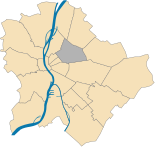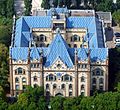Zugló
|
Zugló Lerchenfeld XIV. Budapest district |
|||
|
|||
| Basic data | |||
|---|---|---|---|
| State : | Hungary | ||
| Region : | Central Hungary | ||
| County : | Budapest | ||
| Coordinates : | 47 ° 31 ' N , 19 ° 6' E | ||
| Area : | 18.1 km² | ||
| Residents : | 123.128 (Jan. 1, 2011) | ||
| Population density : | 6,803 inhabitants per km² | ||
| Postal code : | 1141-1149 | ||
| KSH kódja: | 16337 | ||
| Structure and administration (as of 2017) | |||
| Community type : | district | ||
| Structure : | Districts
|
||
| Postal address : | Pétervárad u. 2-4 1145 Budapest |
||
| Website : | |||
| (Source: A Magyar Köztársaság helységnévkönyve 2011. január 1st at Központi statisztikai hivatal ) | |||
Zugló is the name of the 14th district in Budapest . The old German name Lerchenfeld is no longer in use. The district is located east of the center of the city on the Pest side.
Location and dates
The 14th district is located in the inner part of the city. The 4th district is in the north, the 13th district in the northwest and the 15th district in the northeast . The eastern neighbor is the 16th district . The 10th district is in the southeast and the 8th district in the south . Zugló borders the 6th and 7th district in the southwest . The district boundaries run along the line Dózsa György út - Vágány utca - Rákosrendező pályaudvar ("Rákosrendező Station") - Rákosszentmihályi körvasút ("Ringbahn Rákosszentmihály") - Kerepesi út .
With a population of almost 120,000, Zugló ranks third among Budapest's 23 districts. With an area of about 18 km², the 14th district is only in the middle. Despite the relatively high population density, Zugló is a green district. It is often referred to as the lung of the city. For example, there is the City Park, the largest park in Budapest.
There are well-developed transport links to the north of Buda , to the inner Pest areas and with the Gödöllőer HÈV also to the surroundings of the capital.
The 14th district is divided into the following districts: Alsórákos , Herminamező , Istvánmező , Kiszugló , Nagyzugló , Rákosfalva , Törökőr and Városliget .
history
The historic Rákos mezeje ("Rákosfeld") was located on the site of today's Zugló . In the Middle Ages it was an uninhabited wooded swamp area. The Hungarian National Assemblies were held there between 1286 and 1540. Johann Hunyadi was crowned in 1445 in the Rákosfeld. Otherwise, hunters and crab catchers used the area, who found many crabs in the Rákos stream ("crab stream"). In the course of urban development, the forests were gradually cut down.
Emperor Leopold I gave the area to the city of Pest. In the 18th century it was v. a. reforested with willows . With the expansion of the city, the area of the Városliget, which resembles a sandy desert, was cultivated in the 19th century. Palatine Joseph had the Hermina Chapel built in 1842 in memory of his deceased daughter. Since then, the history of today's Herminamező district has been dated. In the middle of the 19th century, the first villas were built on today's Hermina út and the Ajtósi-Dürer sor . In the 1880s and 1890s house construction began in what is now Thököly út and Erzsébet királyné út , and later in the area around Bosnyák tér . In 1869 an ice rink was opened on the lake in the city park. The park was further developed in 1896 as part of the celebrations for the 1000th anniversary of the conquest . In 1906 the Műcsarnok (“Art Hall”), the Szépművészeti Múzeum were completed and the Rákos brook was channeled into the regulated lake. During this time the ring road and the Vajdahunyad Castle were built , which reflect the history of a thousand years of architectural style in Hungary as a three-dimensional museum. A section of the Millennium Railway was built before the turn of the century . The road network in Zugló still reflects the town planning from the turn of the century. The radial arrangement of the streets made traffic easier and connected the so-called sleeping districts and the agglomeration with the center. In the outer area, industrial companies settled at the beginning of the 20th century.
The 14th district was newly created in the course of the restructuring of the districts decided in 1930 together with districts 11 to 13. The area previously belonged to districts 6, 7 and 10. In the decades after the Second World War , several housing developments were built on Füredi útca , Kerepesi út , Nagy Lajos király útja and Kacsóh Pongrác út .
mayor
- 1990–2002: Dr. Zsuzsanna Kardos Kutalikné, SZDSZ, later a coalition of SZDSZ and MSZP
- 2002–2006: Gábor Rátonyi , Fidesz
- 2006–2010: Leonárd Weinek , coalition of SZDSZ and MSZP
- 2010–2014: Ferenc Papcsák , Fidesz
- since 2014: Gergely Karácsony , coalition of Együtt and PM
- since 2019: Csaba Horvath
Important streets and places
|
Streets:
|
|
Places:
|
Building:
|
Culture
The Evangelical Lutheran Theological University (Evangélikus Hittudományi Egyetem) is located in Zugló . In the area of secondary education, the two arts schools Szent István Király Zeneművészeti Szakközépiskola and the Alapfokú Művészetoktatási Intézmény should be mentioned.
Personalities
- Oszkár Asbóth , the inventor of the Asbóth helicopter, lived in Gyarmat utca 7 / c in the 1920s .
- The poet, writer and translator Mihály Babits lived in Dózsa György út 11 from 1901 to 1905 .
- The pianist Mihály Bacher lived from 1981 to 1987 at Ajtósi Dürer sor 5 .
- The historian and writer Ferenc Fejtő lived at Limanova tér 1 from 1931 .
- The writer and philosopher Béla Hamvas lived in Erzsébet királyné útja 13 from 1945 until his death in 1968 .
- The director Zoltán Huszárik lived at Columbus utca 38 .
- The cameraman György Illés , who died in 2006, lived at Róna utca 171 .
- The poet Attila József spent the years 1933 to 1936 at Korong utca 6 .
- Frigyes Karinthy , also a poet, writer and translator, was at home at Thököly út 95 .
- The actor Kálmán Latabár lived in Dózsa György út 17 until his death in 1970 .
- The poets László Nagy and Margit Szécsi lived between 1960 and 1967 in what was then Angol utca 16 (today Derkai utca ).
- The soccer player Ferenc Puskás , captain of the Golden Elf , had his residence from 1954 to 1956 at Columbus utca 57 .
- The author Imre Sarkadi lived in Thököly út 85 from 1949 to 1961 , which is also where
- The poet, writer and journalist Ernő Szép lived.
- The poet and translator Árpád Tóth spent the years 1912 to 1915 in Dózsa György út 11 .
- The actor Jenő Törzs lived at Stefánia út 71 .
- The poet Zoltán Zelk lived at Balázs utca 24 and Columbus utca 54 / b for 20 years .
photos
Individual evidence
- ↑ Lutheran Theological University - information page of the University of Vienna
- ↑ http://www.szentistvanzene.hu/ Homepage of the Szent István Music School
Web links
swell
- Zuglói lexicon . Dinasztia, ISBN 963-657-214-3 .












